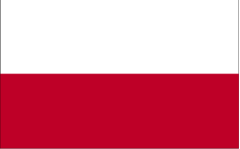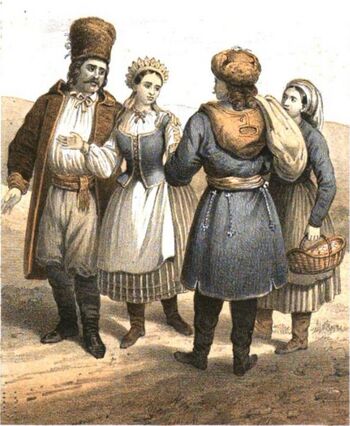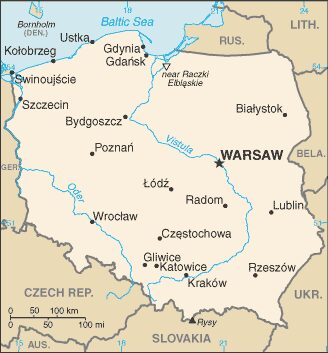Poland

The Republic of Poland (Polish: Rzeczpospolita Polska) is a large Slavic nation in Central Europe. Its history stretches 1000 years, with interruptions when it was controlled or even divided up by powerful neighbors. It is a member of the European Union and NATO.
Geography
Poland is located in Central Europe and occupies a total area of 312,679 square kilometers. It is bordered by Belarus, the Czech Republic, Germany, Lithuania, a Russian exclave Kaliningrad Oblast, Slovakia, and Ukraine. Poland is predominantly open plains, with the natural borders of the Carpathian Mountains to the south and the Baltic Sea to the north.
Demography

Language, Religion, Culture
Religion was a mainstay of Polish identity for a thousand years. It was a refuge from Communist rule, and before that an act of defiance against Prussians and Russians. As the rest of Europe secularized in the late 20th century, the Catholic faith grew stronger in Poland, symbolized by the selection of Karol Cardinal Wojtyła, Archbishop of Kraków, as Pope John Paul II in 1978. Unlike the rest of Europe, the men of Poland were religious, as were the workers, peasants and middle classes. They disobeyed church edicts on birth control and abortion, but they practiced the rituals faithfully.[3] By the late 1980s, a third of all priests ordained in Europe were from Poland.[4]
Economy
Politics
History
- See Poland, history
- see Ukraine
Bibliography
- Library of Congress. A Country Study: Poland (1993), highly detailed factual report by U.S. government (it is in the public domain, with no copyright) online edition
- Poland (Eyewitness Travel Guides by DK Publishing) (2007)
- Parkinson, Tom, Richard Watkins, and Neil Wilson. Lonely Planet Poland (2005) online excerpt and search from Amazon.com
- Podgórecki, Adam. Polish Society Praeger, 1994 online edition
- Turnock, David. The Human Geography of East Central Europe. Routledge. 2002. online edition
History and reference
- Biskupski, M. B. The History of Poland. Greenwood, 2000. 264 pp. online edition
- Bromke, Adam. The Meaning and Uses of Polish History. East European Monographs, 1987. 244 pp.
- The Cambridge History of Poland (two vols., 1941- 1950) online edition vol 1 to 1696
- Davies, Norman. Heart of Europe: A Short History of Poland. Oxford University Press, 1984. 511 pp. excerpt and text search
- Kloczowski, Jerzy. A History of Polish Christianity. Cambridge U. Pr., 2000. 385 pp.
- Lerski, George J. Historical Dictionary of Poland, 966-1945. Greenwood, 1996. 750 pp. online edition
- Lewinski-Corwin, Edward Henry. The Political History of Poland (1917), well-illustrated; 650pp online at books.google.com
- Lukowski, Jerzy and Zawadzki, Hubert. A Concise History of Poland. Cambridge U. Press, 2nd ed 2006. 408pp. excerpts and search
- Pogonowski, Iwo Cyprian. Poland: A Historical Atlas. Hippocrene, 1987. 321 pp.
- Prazmowska, Anita. A History of Poland. Palgrave Macmillan, 2004. 242 pp.
- Sanford, George. Historical Dictionary of Poland. Scarecrow Press, 2003. 291 pp.
- Wróbel, Piotr. Historical Dictionary of Poland, 1945-1996. Greenwood, 1998. 397 pp.
- Zamoyski, Adam. The Polish Way. A Thousand-Year History of the Poles and their Culture. J. Murray, 1987. 422 pp.; heavily illustrated excerpt and text search
External Sources
See also
Notes
- ↑ The colors are somewhat problematic since there is no consensus what are the "correct" colors for the computer screen; this version comes from the CIA World Factbook. Compare with pictures proposed by Polish Ministry of Foreign Affairs [1] and the presidential website.[2] For more details see Flag of Poland.
- ↑ in Henry Sutherland Edwards, The Polish Captivity (1863) p. 175 at [3]
- ↑ In the 1970s there were over 200,000 abortions a year (compared to 600,000 live births), but highly restrictive laws drasticaly reduced the number of abortions after 1988. See Wm. Robert Johnston, "Historical abortion statistics, Poland," (2007) at [4]
- ↑ Stanislaw Gomulka and Antony Polonsky, eds., Polish Paradoxes (1991), pp 237-60
